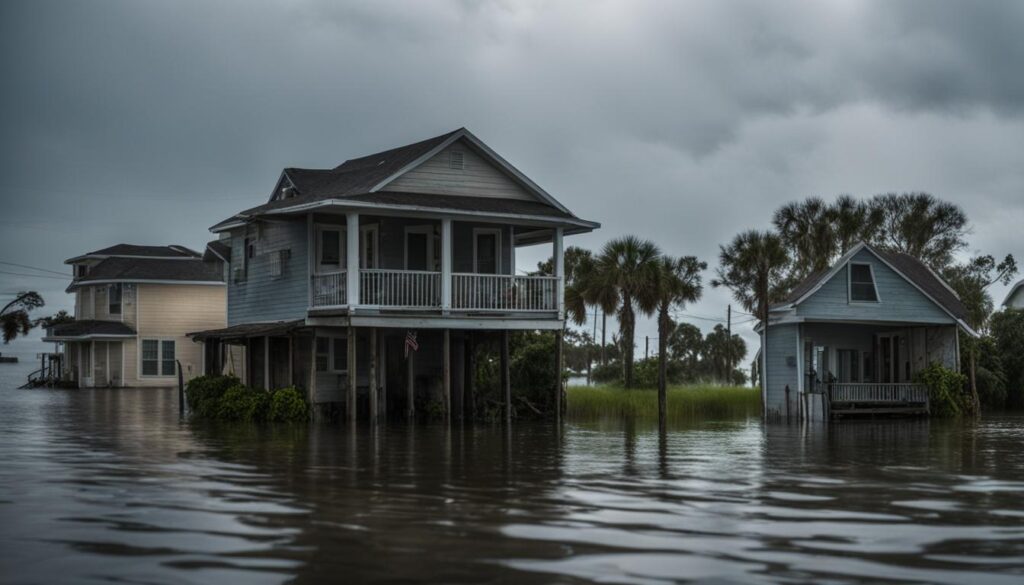Climate change has emerged as a significant threat to property values, particularly in coastal areas. The rising sea levels caused by climate change are projected to have a profound impact on privately owned land, potentially submerging millions of acres within the next 30 years. The consequences could be dire, with a potential reduction of over $108 billion in property value by the end of the century. The encroachment of tides also poses a threat to property tax revenue, which could lead to financial challenges for local governments.
As climate change unfolds, its effects on property values and tax revenue are becoming increasingly apparent. It is crucial for communities and governments to understand and address these challenges to protect both the environment and the economic stability of coastal regions.
Key Takeaways:
- The impact of climate change on property values is a growing concern, especially in coastal areas.
- Rising sea levels could potentially submerge millions of acres of privately owned land.
- The decline in property values could result in a reduction of over $108 billion by the end of the century.
- Property tax revenue for coastal areas may be significantly affected, posing financial challenges for local governments.
- Addressing the impacts of climate change on property values requires comprehensive planning and alternative funding models.
Uneven Distribution of Sea Level Rise Effects
The effects of sea level rise are not evenly distributed across the United States. While climate change poses a threat to coastal properties nationwide, certain regions are particularly at risk due to various factors. Understanding the uneven distribution of sea level rise impacts is essential for assessing coastal property risk and its implications for the climate change housing market.
Coastal Property Risk
Coastal areas on the Atlantic and Gulf Coasts face more significant risks compared to other regions in the country. One key factor contributing to this disparity is land sinking, exacerbating the effects of rising sea levels. As a result, these areas experience a higher susceptibility to flooding and property damage.
For instance, by 2050, it is estimated that 75% of Terrebonne Parish, Louisiana, will be underwater. Hudson County, New Jersey, is projected to witness the submergence of $2.4 billion worth of taxable property, while Galveston County, Texas, could see over 4,200 buildings affected by rising sea levels.
| Region | Projected Impact |
|---|---|
| Terrebonne Parish, Louisiana | 75% submerged by 2050 |
| Hudson County, New Jersey | $2.4 billion worth of taxable property affected |
| Galveston County, Texas | Over 4,200 buildings affected |
Implications for the Climate Change Housing Market
The uneven distribution of sea level rise effects has significant implications for the housing market in coastal areas. Properties located in high-risk regions may experience a decline in value and become undesirable investments due to the increased vulnerability to flooding and property damage. This can create challenges for homeowners, real estate developers, and investors, impacting the supply and demand dynamics of the climate change housing market.
Understanding the specific risks faced by different regions can help inform decision-making processes related to property development, insurance, and climate change adaptation strategies. It is crucial for stakeholders to consider the varying impacts of sea level rise when evaluating coastal property investments and implementing policies to mitigate risks.

Conclusion
As sea levels continue to rise due to climate change, it is essential to recognize the uneven distribution of its effects on coastal properties across the United States. Certain regions, such as the Atlantic and Gulf Coasts, face more significant risks due to factors like land sinking. Understanding these disparities is crucial for assessing coastal property risk and making informed decisions in the climate change housing market. By considering the implications of sea level rise on coastal areas, stakeholders can proactively address the challenges and uncertainties associated with climate change impacts on property values and investments.
Implications for Local Governments and Funding Challenges
As the impacts of climate change continue to manifest, the real estate industry faces significant challenges in terms of adaptation and mitigation. Coastal areas are particularly vulnerable to rising sea levels and increased flood risks, which in turn have implications for local governments and their funding. The need to climate-proof real estate and invest in resilience measures is crucial, but it comes with financial constraints and funding challenges.
Coastal property is often the most valuable and generates substantial property tax revenue for local governments. However, as sea levels rise, there is a profound risk of property value decline and loss of tax revenue. This creates a double-edged sword, where municipalities face a compounding problem of decreased property values and limited resources to invest in climate change adaptation measures.
To address these funding challenges, municipalities often rely on municipal bonds to finance resilience projects. However, the increasing risk associated with climate change impacts may result in higher borrowing costs, making it even more challenging for local governments to secure the necessary funding. This creates a cycle where the very measures needed to adapt to climate change become more difficult to attain.
The Rising Costs of Climate Adaptation
Table 1 provides an overview of the estimated costs associated with climate change adaptation in coastal areas. These costs include the construction of seawalls, flood-proofing infrastructure, and elevation of roads and buildings. The data highlights the financial burden faced by municipalities as they strive to protect their communities from the impacts of climate change.

| Climate Adaptation Measure | Estimated Cost |
|---|---|
| Construction of Seawalls | $X million |
| Flood-Proofing Infrastructure | $Y million |
| Elevation of Roads and Buildings | $Z million |
Without adequate funding, municipalities may struggle to implement necessary adaptation measures, leaving their communities at greater risk. Alternative funding models, such as sales/consumption taxes, stormwater impact fees, and resilience bonds, can offer potential solutions. Regional sharing of land and taxes, as well as legislation to empower low-income neighborhoods, can also help stabilize housing and expand revenue sources for climate adaptation efforts.
Choices for Future Development and Funding Models
As the impacts of climate change and rising sea levels become more apparent, it is crucial for coastal communities to make informed choices for future development and implement sustainable funding models. To mitigate the risks associated with climate change, stricter restrictions on new developments should be put in place, ensuring that construction occurs within low-risk zones. This will help protect both existing and future property values.
To address the funding challenges posed by climate change adaptation, municipalities need to explore alternative revenue sources. One possibility is the implementation of sales/consumption taxes, which can provide a stable source of income for climate resilience projects. Additionally, stormwater impact fees could be levied on property owners, helping to fund infrastructure improvements that mitigate flood risks.
Another option worth considering is the issuance of resilience bonds. These bonds would allow municipalities to borrow money specifically for climate adaptation projects, spreading the cost over time and ensuring that necessary investments can be made. By diversifying revenue streams and exploring innovative funding models, communities can better protect their coastal properties and secure a sustainable future in the face of climate change.
Benefits of Alternative Funding Models for Climate Change Adaptation
Implementing alternative funding models for climate change adaptation brings a range of benefits to both individuals and communities. Firstly, by diversifying revenue sources, the burden of funding resilience projects is shared more equitably among stakeholders. This can help avoid placing an undue financial burden on property owners and ensure that everyone contributes their fair share to protecting coastal properties.
Secondly, alternative funding models provide a stable and reliable source of income for climate resilience projects. By establishing revenue streams such as sales taxes or stormwater impact fees, communities can ensure a consistent flow of funds for ongoing infrastructure improvements and environmental protection initiatives.
Lastly, exploring alternative funding models opens up opportunities for innovation and collaboration. By thinking outside the box and considering non-traditional funding sources, municipalities can tap into new resources and leverage partnerships to maximize the impact of their climate adaptation efforts. This can lead to more comprehensive and effective strategies for protecting coastal properties and ensuring long-term sustainability.
Florida’s Vulnerability to Climate Change and Property Loss
A study conducted by Cornell and Florida State Universities reveals that around one million properties in Florida are projected to become chronically flooded, resulting in a combined assessed value loss of $619 billion. This alarming forecast highlights the urgent need for comprehensive climate adaptation measures in the state. Florida, with its extensive coastline and low-lying geography, is particularly susceptible to the impacts of rising sea levels and increased flood risks caused by climate change.
Local governments in Florida must prioritize long-term planning and strategic investments to address the challenges posed by sea level rise. This requires collaboration between various stakeholders, including policymakers, researchers, and community members. Climate adaptation researchers play a crucial role in providing valuable insights and data-driven solutions to help local governments make informed decisions in their planning and resource allocation.
The threat of flood-prone buildings and infrastructure is a pressing concern for Florida’s coastal communities. Proper planning and regulations are necessary to protect these vulnerable areas and prevent further property loss. Identifying and implementing effective sea level rise planning strategies, such as building codes and zoning requirements that consider future flood risk, can help mitigate the potential damage and minimize the financial and emotional toll on homeowners and communities.

Table: Projected Property Loss in Florida due to Chronic Flooding
| County | Number of Properties | Assessed Value Loss (in billions) |
|---|---|---|
| Miami-Dade | 217,333 | $49.8 |
| Broward | 103,572 | $30.7 |
| Monroe | 27,037 | $9.5 |
| Palm Beach | 87,992 | $26.1 |
| Pinellas | 55,495 | $9.7 |
The projected property loss in Florida due to chronic flooding is just one aspect of the multifaceted challenges posed by climate change. It is imperative for policymakers and stakeholders to recognize the urgency of the situation and take proactive measures to protect property values, safeguard communities, and ensure the long-term resilience of Florida’s coastal areas.
Concentration of Negative Equity and Its Effects on Homeownership
Despite improvements in the housing market, there is still a significant number of homeowners in the United States who find themselves in a precarious situation known as negative equity. This occurs when the homeowner owes more on their mortgage than their home is currently worth. According to recent data, there are approximately 3.2 million homeowners in this situation, with over 16% of them concentrated in the bottom price tier of the market.
The aftermath of the housing market crash in 2008 left many homeowners trapped in negative equity, and while the situation has improved, its effects are still being felt. For those who are underwater on their mortgages, selling their homes becomes extremely challenging, as they would need to come up with additional funds to cover the shortfall between the sale price and the remaining mortgage balance.
This concentration of negative equity has broader implications for the housing market and homeownership, particularly for young renters looking to transition into homeownership. The inability to sell homes in negative equity prevents these potential buyers from entering the market, further stalling the recovery and impacting overall housing market stability. It is estimated that it will take several more years to reach pre-housing crash levels due to the lingering effects of negative equity.
The Impact on the Housing Market
The presence of negative equity creates a challenging environment for the housing market. With a significant number of homeowners unable to sell their homes, the supply of available properties for sale decreases. This restricted supply, combined with high demand, can drive up home prices, making it even more difficult for prospective buyers to enter the market. Additionally, the lack of mobility for homeowners with negative equity limits their ability to relocate for job opportunities, further exacerbating economic instability.
The concentration of negative equity in the lower-priced segment of the market has implications for housing affordability. As home prices continue to rise, many potential buyers are priced out of the market, leading to a decrease in homeownership rates. This can have long-term consequences for wealth accumulation and economic stability, as homeownership has traditionally been a significant factor in building and preserving wealth for individuals and families.
The Path to Recovery
Overcoming the challenges posed by negative equity requires a multi-faceted approach. Efforts should be focused on helping homeowners refinance their mortgages to take advantage of low-interest rates, allowing them to reduce their monthly payments and potentially regain equity in their homes. Government initiatives and programs can play a crucial role in facilitating this process and providing support to homeowners in need.
Additionally, policies aimed at increasing housing supply and promoting affordable homeownership opportunities can help mitigate the impact of negative equity. This includes incentivizing the construction of affordable housing, providing down payment assistance programs, and implementing measures to stabilize and strengthen the housing market.
Addressing the concentration of negative equity and its effects on homeownership is essential for achieving a more inclusive and resilient housing market. Through targeted strategies and collaborative efforts between government, housing agencies, and financial institutions, it is possible to mitigate the long-term impact of negative equity and provide opportunities for sustainable homeownership.
Conclusion
In conclusion, climate change poses significant challenges to property values and the ability of local governments to adapt. The rising sea levels and subsequent loss of property value and tax revenue require comprehensive planning and stricter development regulations. It is also crucial to explore alternative funding models to support climate adaptation efforts.
To mitigate the impacts of climate change, it is essential to focus on climate change mitigation strategies, such as reducing emissions and implementing long-term adaptation plans. By taking early action and making informed choices, communities can work towards better outcomes and safeguard property values in the face of climate change.
Managing property values in the context of climate change requires a holistic approach. This includes considering the uneven distribution of sea level rise effects and the implications for local governments. It also involves making choices for future development and exploring different funding models to support flood-prone communities. By addressing these challenges head-on, we can ensure a more resilient future for our coastal areas and protect the value of our properties.
FAQ
What are the potential impacts of sea level rise on property values?
Rising sea levels due to climate change could lead to the submergence of nearly 650,000 privately owned parcels of land, resulting in a reduction of over $108 billion in property value by the end of the century.
How will rising sea levels affect property tax revenue for coastal areas?
The encroachment of tides could lead to a substantial decrease in property tax revenue for coastal areas, potentially bankrupting local governments.
Which regions in the United States will experience the most significant impacts of sea level rise?
The Atlantic and Gulf Coasts are expected to experience more significant impacts, with areas such as Terrebonne Parish, Louisiana, Hudson County, New Jersey, and Galveston County, Texas, facing substantial property loss.
What are the implications of sea level rise on local government funding for climate change adaptation?
As sea levels rise, there will be a significant loss of revenue for municipalities, making it more challenging to fund climate change adaptation measures such as building seawalls or elevating roads.
How can the impacts of climate change on property values be mitigated?
Stricter restrictions on new developments and building in high-risk zones are recommended. Municipalities could explore alternative revenue sources such as sales taxes, stormwater impact fees, and resilience bonds.
What is the projected impact of climate change on properties in Florida?
A study suggests that around one million properties in Florida are projected to become chronically flooded, resulting in a combined assessed value loss of $619 billion.
How does negative equity impact the housing market?
There are still 3.2 million homeowners in the United States who owe more on their mortgages than their homes are currently worth, negatively impacting the housing market, especially for young renters looking to become homeowners.
Can Eco-Friendly Housing Have a Positive Impact on Property Values Despite Climate Change Risks?
Can eco-friendly housing mortgages have a positive impact on property values despite climate change risks? Sustainable, energy-efficient homes are gaining popularity as individuals actively seek ways to reduce their carbon footprint. The demand for eco-friendly housing is increasing, making these properties attractive to potential buyers who value sustainability. As environmental concerns grow, the market value of such houses may rise in the long run, proving that investing in eco-friendly housing mortgages can be a wise and lucrative decision.


Pingback: Rising Tides, Rising Costs: How Climate Change is Hiking Your Insurance! – Straight Fire Money